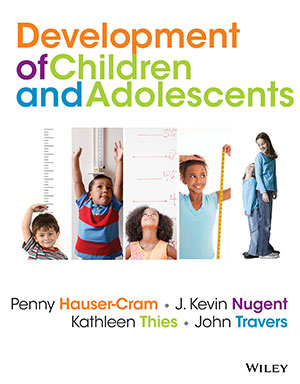
The Development of Children and Adolescents: An Applied Perspective
By Penny Hauser-Cram, J. Kevin Nugent, Kathleen Thies, John F. Travers
The Development of Children and Adolescents, by Penny Hauser-Cram, J. Kevin Nugent, Kathleen Thies, and John F. Travers, provides an integrated view of child development. Presenting the most pertinent research for each developmental stage and linking this to practical applications in the areas of Parenting, Policy, and Practice, this balanced approach emphasizes the relationship between research and theory and applications.
The rich media program, including WileyPLUS with Real Development promotes active learning and allows for increased understanding and comprehension of the course content. The Real Development program is made up of authentic video showcasing real families along with activities and assessments that help students gain an understanding of key developmental concepts. Through the combination of text and media, students are engaged in meaningful learning that deepens and enriches their understanding of developmental concepts.
Schedule a Demo Sign Up for a Test Drive Adopt WileyPLUSWant to learn more about WileyPLUS? Click Here
Real Development
Real Development is an innovative, multimedia product using authentic video of four real families in a variety of naturalistic and professional settings.
Real Development assessment activities ask students to analyze and critically evaluate child development concepts and scenarios from the perspective of a professional or parent. A video library with observational footage and interviews with children and professionals is included to further illustrate key concepts of child development in today’s world.
Real Development is integrated with WileyPLUS, a research-based, online environment for effective teaching and learning.
Parenting, Policy, and Practice
Parenting, Policy, and Practice applications are integrated throughout each chapter, highlighting knowledge that will help students both as parents and in their chosen occupations, including education, nursing, childcare, psychology, and social work.
What Happens in the Brain
What Happens in the Brain two-page spreads throughout the book illustrate what happens in a child’s brain when they are performing everyday activities from reading to riding a bike. This feature helps students understand the neural mechanisms at work in the child’s developing brain.

Penny Hauser-Cram is a professor at Boston College in the Lynch School of Education. She received her Ed.D. in Human Development from Harvard University in 1983 and her research focuses on children and adolescents with developmental disabilities and children and adolescents living in poverty.

Kevin Nugent is Professor of Children, Families and Schools at the University of Massachusetts at Amherst and has been on the faculty there since 1986. He received his Ph.D. from Boston College and he is the founder and director of the Brazelton Institute in the Department of Developmental Medicine at Children’s Hospital in Boston and is on the faculty at Harvard Medical School. His research focuses on early childhood development, cross-cultural study of child development and assessment and early intervention.

Kathleen Thies received her Ph.D. from Boston College and is currently the director of the Graduate Entry Pathway for the UMASS School of Medicine. She is both a developmental psychologist and a clinical specialist in mental nursing. She has extensive experience in the development of community-based nursing education and partnerships with clinical affiliates.

John Travers passed away in the spring of 2011. He was a professor at Boston College in the Lynch School of Education where he taught for more than 50 years. He is the author of a number of books in developmental and educational psychology.
PART ONE – INTRODUCTION
Chapter One: A Child’s Journey
PART TWO – BIOLOGICAL BEGINNINGS
Chapter Two: Biological Foundations of Child Development
Chapter Three: Prenatal Development
Chapter Four: Birth and the Newborn
PART THREE – INFANCY
Chapter Five: Physical Development and Health in Infancy and Toddlerhood
Chapter Six: Cognitive Development in Infancy
Chapter Seven: Psychosocial Development in Infancy
PART FOUR – EARLY CHILDHOOD
Chapter Eight: Physical Development and Health in Early Childhood
Chapter Nine: Cognitive Development in Early Childhood
Chapter Ten: Psychosocial Development in Early Childhood
PART FIVE – MIDDLE CHILDHOOD
Chapter Eleven: Physical Development and Health in Middle Childhood
Chapter Twelve: Cognitive Development in Middle Childhood
Chapter Thirteen: Psychosocial Development in Middle Childhood
PART SIX – ADOLESCENCE
Chapter Fourteen: Physical Development and Health in Adolescence
Chapter Fifteen: Cognitive Development in Adolescence
Chapter Sixteen: Psychosocial Development in Adolescence

